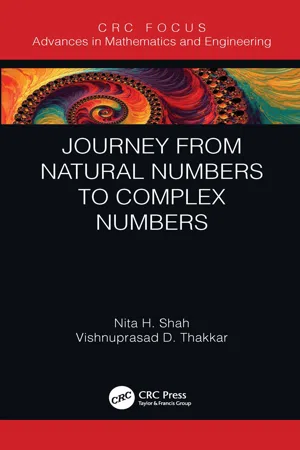
- 88 pages
- English
- ePUB (mobile friendly)
- Available on iOS & Android
Journey from Natural Numbers to Complex Numbers
About this book
This book is for those interested in number systems, abstract algebra, and analysis. It provides an understanding of negative and fractional numbers with theoretical background and explains rationale of irrational and complex numbers in an easy to understand format.
This book covers the fundamentals, proof of theorems, examples, definitions, and concepts. It explains the theory in an easy and understandable manner and offers problems for understanding and extensions of concept are included. The book provides concepts in other fields and includes an understanding of handling of numbers by computers.
Research scholars and students working in the fields of engineering, science, and different branches of mathematics will find this book of interest, as it provides the subject in a clear and concise way.
Frequently asked questions
- Essential is ideal for learners and professionals who enjoy exploring a wide range of subjects. Access the Essential Library with 800,000+ trusted titles and best-sellers across business, personal growth, and the humanities. Includes unlimited reading time and Standard Read Aloud voice.
- Complete: Perfect for advanced learners and researchers needing full, unrestricted access. Unlock 1.4M+ books across hundreds of subjects, including academic and specialized titles. The Complete Plan also includes advanced features like Premium Read Aloud and Research Assistant.
Please note we cannot support devices running on iOS 13 and Android 7 or earlier. Learn more about using the app.
Information
1
Natural Numbers
1.1 Prerequisites
1.1.1 Set Theory
Table of contents
- Cover
- Half-Title
- Series
- Title
- Copyright
- Contents
- Preface
- Author biographies
- 1 Natural Numbers
- 2 Integers
- 3 Rational Numbers
- 4 Real Numbers
- 5 Complex Numbers
- Index